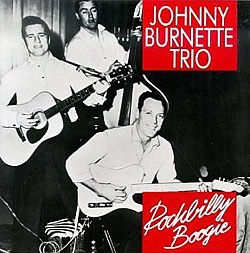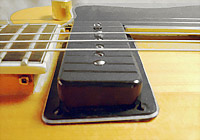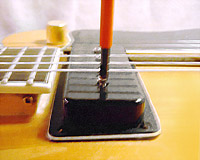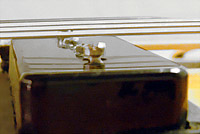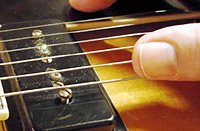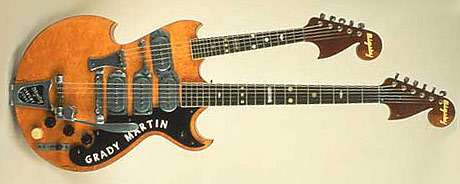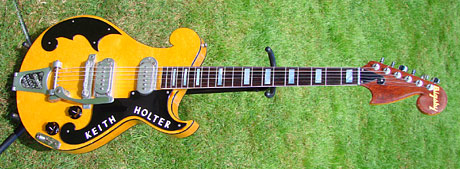Johnny Burnette & The Rock'n'Roll Trio
Did Paul Burlison or Grady Martin play guitar
for Johnny Burnette & The Rock'n'Roll Trio?
and
who "invented guitar distortion"?
By Vince Gordon & Peter Dijkema A Fender Esquire has not got a "fat" tone...For years, it never struck me that anyone but Paul Burlison could be playing the brilliant lead guitar, on some of the classic Rock'n'Roll Trio songs recorded at Owen Bradley's Quonset Hut studio in Nashville. Songs like: Lonesome Train, Sweet Love On My Mind, Rock Billy Boogie and Rock Therapy. I used to tell people, who asked me rockabilly gear questions, that the only one I ever heard who got a fat and full sound out of an Esquire/Telecaster was Paul Burlison on some of the Quonset Hut recordings. Today I believe the mystery is solved: It wasn't Paul Burlison playing a Fender Esquire/Tele at all, but instead Grady Martin playing with his trademark fat tone, used on numerous rockabilly recordings.
|
This is probably how it was done…
When thinking about how the distortion/fuzz was created, I was looking for a method that would result in what you hear on the record: 1. Only the deep E-string is really distorted. The other strings have a normal distortion for a 50ties tube amp. (Some of the blues stuff recorded at Sun was considerably more distorted, than the treble strings on these two songs). 2. The deep E-string is a whole lot louder (volume) than the other strings. Sometimes the thin E-string almost disappears in the background for instance. 3. Especially on Honey Hush, you frequently hear a strange “clang” noise together with notes played on the deep E-string. Even sometimes, you only hear the "clang" where there obviously should have been played a note on the deep E-string. I realised that all these things had little to do with the amp, but a lot to do with the pick-up on the guitar. The explanation is simple: First you set your amp to have what would qualify as normal distortion for the time period, but with a lot of bass. Then you take a screw driver and raise the pole piece on the pickup under the deep E-string – and only that one. Raise it as much as possible without making the string unplayable and there’s your Train Kept A-Rollin’/Honey Hush distortion. It results in: 1. Only the deep E-string is really distorted and in a fuzzy way. 2. The deep E-string is a whole lot louder than the other strings. 3. If you hit the deep E-string too hard (Especially when playing on the bridge pick-up and resting your palm around the bridge area, this is likely to happen) it will make physical contact with the pole piece and the result will be a “clang” noise, sometimes without a note. On the right you can see what I did and try it out for yourself. I recorded the intro from The Train Kept A-Rollin’ and an improvised solo similar to the one on Honey Hush, so that you can hear the result.
Given the fact that I only used the gear I had at hand and recorded it with a modern microphone, the result is amazingly similar. If someone knew what guitar, strings and amp was used and had a RCA 44 microphone, I’m pretty sure the sound could be nailed completely. The gear used on my recording: My customized Epiphone with a Seymour Duncan vintage P-90 in the neck position and a vintage FilterTron pup at the bridge played through my 50ties, Fender Bassman’ish set up (You can read all about it at the main page, The Rockabilly Guitar Page). One Joe Meek JM47 microphone. I started out with the P-90 pickup because I suspected it to have the better sound for this purpose, compared to the FilterTron (The FilterTron was actually not introduced till '57, but that's beside the point). I also tried out the FilterTron in the bridge position and found out that, although the P-90 sounds more like the pickup being used on the Burnette recordings, the overall result was better when I used the FilterTron, simply because it was in the bridge position. That means it's important for the sound, to use the bridge pick up (The strings vibrate very differently at the bridge, than at the neck). Given the fact the FilterTrons were specifically designed by Ray Butts to accommodate Chet Atkins wish for a less dominant and muddy bass than that of the DeArmond Dynasonics, it’s amazing that I can get so close to the Honey Hush and Train sound with its particularly dominant and muddy bass. Other explanations?I’ve heard many other explanations trying to account for all the specific elements of the sound, but the only one I think is plausible comes from Juan C. Rodriguez of Blue Lake Records, who thinks that the bass is heard more because a (thumb?)pick is used and the high string is only picked with a finger.
Who played the solos then?Given Burlison's unlikely explanations about the whole event, I don't see how he could have played the solos. Apart from that, the technical level is too high for his playing. For once, the timing on Tear It up and Oh, Baby Babe leaves a lot to be desired, whereas the timing on Train and Honey Hush is dead-on groovy, which is the typical trademark of a session musician. The choice of notes is very similar to Rock Billy Boogie and the other Nashville tracks and have nothing to do with what Burlison played in New York. It was Grady Martin. My co-writer and I have no doubt about it.
What gear was used?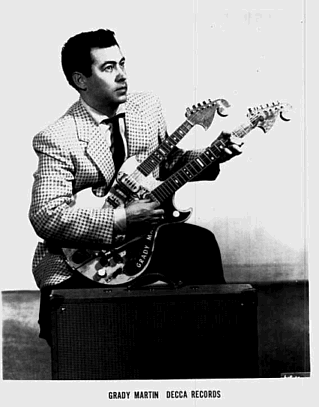 Guitar: The most unlikely guitar would be a Fender Tele/Esquire, really. It could have been a number of guitars, as the tone was typical/popular for that age. It sounds P-90/Charlie Christian/DeArmond'ish and that doesn't narrow it down very much, now does it :-) Also, Grady Martin was known to have played many different guitars. Still we're 99% sure it was Grady Martin's custom made 1952 Bigsby Doubleneck guitar with 3+1 pickups and of course a Bigsby vibrato tail piece that was used (The "extra" neck is actually a mandolin and not a guitar). This theory was also our initial guess, mostly because the guitar sound wasn't exactly like anything else we've heard - apart from Grady Martin's other work. We felt we had to abandon that theory for a while however, after hearing from Deke Dickerson. He reported that the guitars he had tried with Bigsby pick-ups, had a squeaky clean tone, which is something you can hardly say about any of the Nashville sessions. Some time later Dickerson contacted us again after he had played a 1953 Bigsby guitar with appointments close to that of Martin's 1952 Bigsby doubleneck. He reported that it sounded hotter than the other guitars he tried up untill then. Dickerson's words were: "When I played a few of the signature licks from the Johnny Burnette records on Keith's guitar--"Lonesome Train," "Lonesome Tears In My Eyes," "Baby Blue Eyes," etc....THERE WAS THE SOUND. There was no mistaking it. The sound was absolutely identical to the Johnny Burnette Trio recordings." Of course we don't know for sure, but for us, that setteles the issue of what guitar was used. The guitar Deke Dickerson tried was from original Bigsby guitar owner Keith Holter, who still has his guitar (and holds on to it!). For those interested in the technical side of it, we can inform you that we investigated if some Bigsby pickups might have been hotter than others, but Paul Yandell (Who has owned 15 Bigsby pickups out of the approx. 200 ever made) said that all of his were 3KOhm (Which is very weak compared to other popular pups btw.) It is likely then, that all Bigsby pups are about 3KOhm.
Amplifier: Martin owned a Magnatone amp and there was often a Standel 25L15 in the studio (Cliff Gallup used one when recording with Gene Vincent). Owen Bradley had a Tweed Pro with a 15" JBL retrofitted speaker in it, which at low volumes probably sounded a lot like a Standel. Any of those amps could have done the trick and then there's Burlisons Deluxe, of course. Bob Moore tells me that most likely Grady used whatever amp was there at the Quonset Hut. Grady didn't usually haul his own special amp around to record sessions. Our guess is that Martin played through a Standel (FYI: Deke Dickerson's bet is on Martin's Magnatone), with the bass control turned up loud and the treble down. This set up (In mine and my co-writer's opinion) would result in a more muddy bass and slightly cleaner treble strings, compared to my test recording. We had a Standel owner test this and he verifies that a Standel 25L15, can be made to boost the bass AND distort. This is what my recording lacks to nail the sound completely (And of course the actual room and the RCA 44 microphone). |
All recording sessions of Johnny Burnette & The Rock'n'Roll Trio
I've made a session list of who played lead guitar, bass and who produced Johnny Burnette & The Rock'n'Roll Trio. It might not be 100% accurate as these things are very hard to find out, but the general picture is there. If you have some information about this, I'd like to hear from you so we can get it as accurate as possible.
Session:May 7, 1956, Pythian Temple, New York. Engineer : Bob Thiele Songs:Comments:Typical Tele/Esquire-Fender amp sound (thin), single string picking. Paul Burlison played a blonde whiteguard Fender Esquire (One single coil pickup) through a tweed Fender DeLuxe amp.
|
Session:July 2, 1956, Owen Bradley's Quonset Hut studio, Nashville. Producer : Owen Bradley Songs:
|
Session:July 3, 1956, Owen Bradley's Quonset Hut studio, Nashville. Producer : Owen Bradley Songs:
|
Session:July 4, 1956, Owen Bradley's Quonset Hut studio, Nashville. Producer : Owen Bradley Songs:
|
Session:July 5, 1956, Owen Bradley's Quonset Hut studio, Nashville. Producer : Owen Bradley Songs:
|
Session:March 22, 1957, Owen Bradley's Quonset Hut studio, Nashville. Producer : Owen Bradley Songs:Comments:By this time Dorsey Burnette and Paul Burlison had left the group. There's no reason why they should be on these recordings.
|
If you're interested in knowing more about the recordings of Johnny Burnette & The Rock'n'Roll Trio this is a very good site. Needless to say, we don't agree with all their personnel listings. Just for the record, we agree with all of them besides the lead guitar listings.
|
Bottom line
There's no doubt in my mind that Paul Burlison wanted to play the lead on all the recordings. There's no reason to think it was his decision not to play. After the records were released, Johnny Burnette & The Rock'n'Roll Trio were promoted as if Burlison had played the lead guitar. Again, this was not his decision and something he might just have got caught up in, like so many other band musicians have been, before and after him.
This article is not a moral crusade in any way, be it pro or con band or session musicians, Grady Martin or Paul Burlison or the way record companies promote their acts. The entertainment industry is based on illusions. Generally speaking fans, then and now, like to believe that anyone can walk off the street and into the studio and become rich and famous just by being talented or maybe not even that. The truth however, is that great music is made by people who have worked hard to learn how to make it. This is true for musicians as well as producers, engineers, people who program sequencers and anyone producing music in any form.
Grady Martin had worked really hard to get so good. I’ve heard it said that he played up to 10 hours a day. Burlison was an electrician by trade. Of course he couldn’t compete with that. He did his best as you can hear on the Pythian Temple sessions and his intentions were honest, I’m sure. This is no “Milli Vanilli” example. Paul Burlison went on the road with Johnny Burnette & The Rock’n’Roll Trio and played his heart out to promote the albums. This article is only about getting some facts straight. Nothing else.
Paul Burlison (1929 - 2003) was a great guitarist and he definitely deserves his place in Rock'n'Roll history, but Grady Martin (1929 -2001) was a brilliant guitarist and he should be credited for some of the best rockabilly guitar work ever, simply because he did it.
To me, an important part in all this is that anyone who wants to learn to play really good rockabilly guitar, should study Grady Martin and not so much Paul Burlison. I never studied Martin (Not knowingly anyway) but I certainly would have, if I’d known it was him, who played the best stuff for Johnny Burnette & The Rock'n'Roll Trio.
What do you think?
While my co-writer and I have no doubt that this article is true in its substance, we do not expect it to be flawless. If you have some information on the subject, whether you agree or disagree, we'd like to hear from you. You can just send an email.
Credits: |
